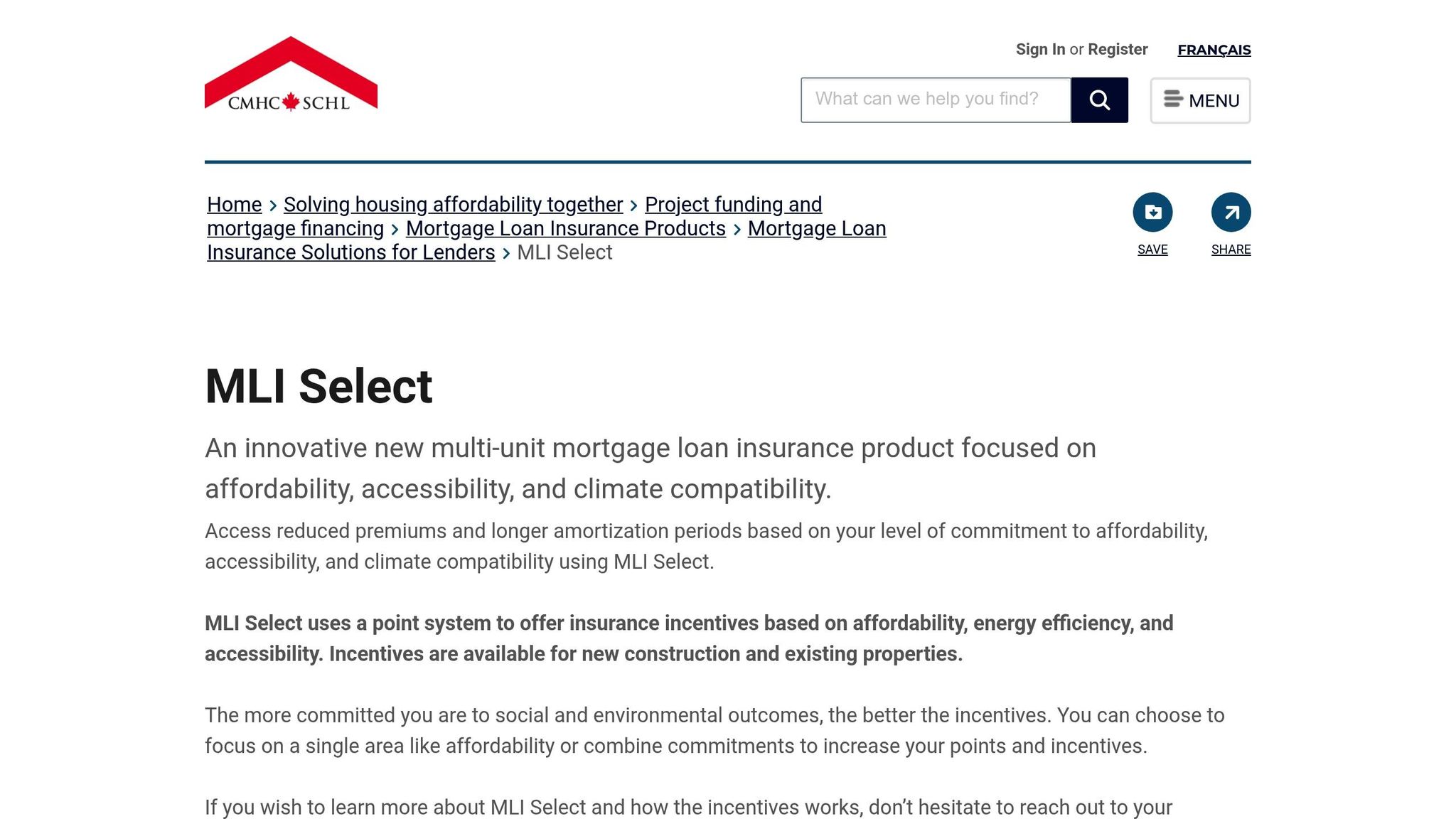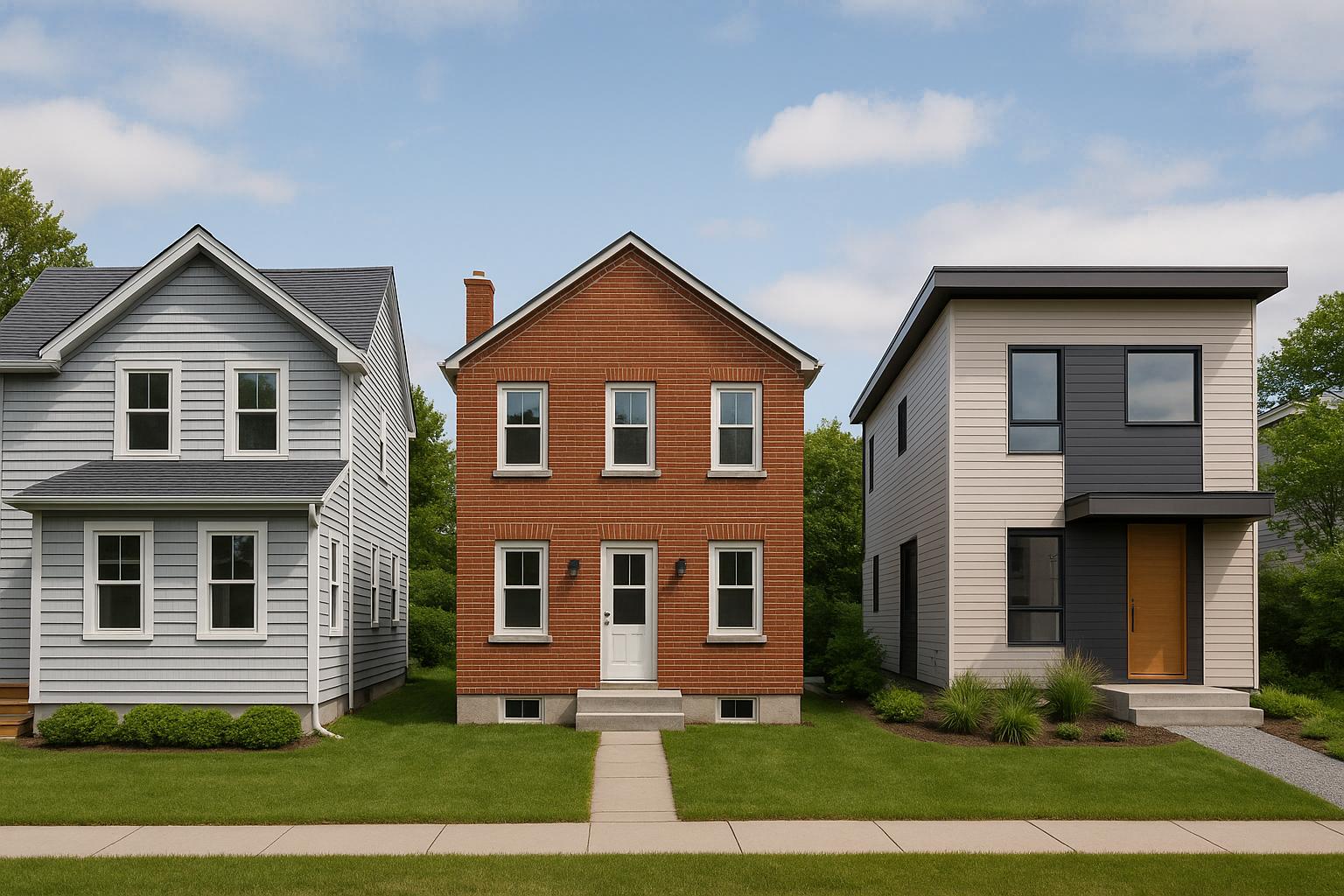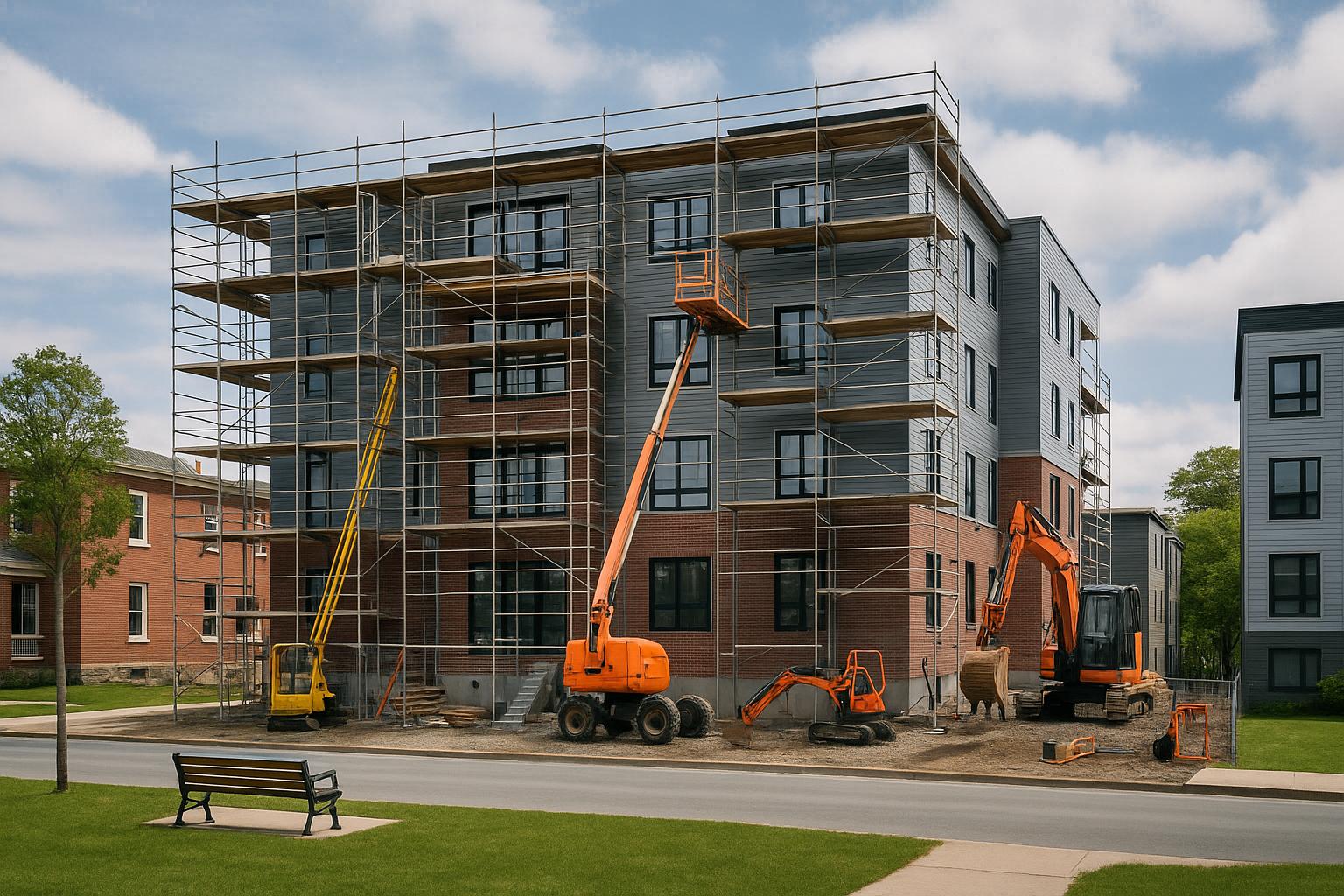If you're considering multi-unit rental construction, Central Nova Scotia offers strong potential for investment. Here's why:
- Lower Costs: Construction and land costs are more affordable compared to Halifax.
- High Demand: Rental demand is rising due to a housing shortage, with two-bedroom units in Truro renting for $1,950–$2,100/month.
- Attractive Returns: Annual returns for investors typically range from 12% to 20%.
- Accessible Location: Truro's proximity to Halifax (90-minute drive) appeals to commuters looking for budget-friendly housing.
- Streamlined Construction Options: Integrated design-build models reduce costs and delays, ensuring projects stay on track.
Whether you're a first-time developer or a seasoned investor, Truro's rental market, combined with government-backed programs like CMHC MLI Select, makes it a practical choice for profitable, efficient projects.
Truro & Area Real Estate Report for April 2024 with Andrew Keddy, REALTOR® Royal LePage Real Estate
Truro's Rental Market Data and Trends
Truro's rental market presents promising opportunities for multi-unit construction investments, especially for two-bedroom units that align with property owners' financial goals.
Current Rental Rates and Occupancy Data
Two-bedroom units in Truro currently rent for $1,950 to $2,100 per month, offering a solid foundation for new construction projects. These rental rates can generate annual returns ranging from 12% to 20%, particularly for properties with desirable features that command the higher end of the price range. This data highlights the market's potential and sets the stage for understanding the tenant base.
Tenant Types and Seasonal Patterns
Truro's tenant mix adds to the market's stability. Thanks to its proximity to Halifax - just a 90-minute drive - the area attracts a blend of professionals and families. This diversity ensures consistent, long-term demand, providing property owners with a dependable stream of rental income throughout the year.
Short-Term Rental Considerations
For those looking to diversify income, short-term rentals can be an appealing option. However, it's essential to review municipal bylaws and meet provincial safety standards before venturing into this market segment.
Land Purchase and Municipal Permits
Securing the right land and obtaining the necessary permits are crucial steps in ensuring smooth multi-unit construction. These early decisions can help minimize delays and keep costs under control.
How to Choose the Right Building Site
Start by confirming that your chosen site aligns with local zoning requirements for multi-unit residential development in Truro and Colchester County. This is a critical first step to avoid potential roadblocks later on.
Truro offers affordable land, which can significantly improve your investment returns. However, it's not just about the price - make sure the site has access to essential utilities like water, sewer, and electricity. Checking with Colchester County's Planning Department (902-897-3166) can save you from unexpected expenses tied to utility upgrades.
Accessibility is another key factor. Properties near major roads, public transit, and local amenities such as workplaces, hospitals, and schools are more likely to attract and retain tenants. Once you've found a site that meets these criteria, the next step is securing the required permits to move forward.
Getting Development and Building Permits
Before you can break ground, you'll need to obtain development permits, followed by building permits. For development permits, you'll typically need to submit a comprehensive set of documents, including site plans, architectural drawings, soil tests, and environmental assessments. Keep in mind that the review process can take several weeks - or longer for more complex projects.
Building permits require even more detailed documentation, such as construction drawings approved by a Professional Engineer, along with mechanical and electrical plans. Fees will depend on the size and scope of your project. Be prepared for municipal inspections at key stages, including the foundation, framing, and final occupancy. These inspections must be scheduled in advance, and any issues identified can lead to delays and additional costs.
For larger buildings, especially those with significant height or unit counts, fire department approvals are often required. The fire department will review plans for safety features like sprinkler systems and emergency access, so be sure to account for this extra step in your timeline.
Permit Problems and Solutions
Even with thorough preparation, challenges with permits can arise.
Incomplete applications are a common issue. Missing documents, such as updated survey certificates or engineering stamps, can delay approvals. To avoid this, work with professionals who are familiar with local requirements to ensure your submissions are complete.
Neighbourhood concerns can also slow the process. If your project is near existing residential areas, factors like building height, parking, and landscaping may face additional scrutiny. Addressing these concerns proactively in your application can help expedite approvals.
Soil conditions can present another hurdle. For instance, high clay content or fluctuating water tables may require specialized foundation designs. A geotechnical report early in the planning phase can identify these challenges and save you from costly redesigns later.
In older neighbourhoods, utility capacity might be insufficient to support new developments. Assessing the capacity of local electrical and water systems during site selection can help you avoid delays caused by necessary upgrades.
To streamline the entire process, consider working with an integrated design-build team. This approach ensures all requirements are coordinated from the start, reducing the risk of miscommunication and delays.
sbb-itb-16b8a48
Construction Methods: Fragmented vs Integrated Approach
When building in Truro, property owners face a critical choice: hire separate professionals for each phase of the project or go with an integrated design-build approach. This decision can significantly affect costs, timelines, and the overall stress involved in the process.
Problems with Fragmented Construction
Fragmented construction involves hiring separate architects, engineers, contractors, and subcontractors who work independently. While this may seem straightforward, it often leads to miscommunication and poor coordination. For example, an architect might design a structure without fully consulting the engineer, leading to structural issues. Similarly, electricians and plumbers working under different supervisors can create conflicting systems, increasing the likelihood of errors.
The cost implications are steep. With cost-plus pricing, a project initially estimated at CA$640,000 can easily balloon to CA$900,000 or more - an overrun of 30–60%.
Delays are another common issue. Weather, material shortages, or miscommunication can push timelines back, postponing rental income and sparking costly disputes. Contractors might blame the architect’s plans, engineers might point to unassessed site conditions, and municipalities could reject incomplete permit applications. In the end, property owners are left juggling disputes instead of focusing on their investment.
These challenges highlight why an integrated design-build approach is often a better option.
Benefits of Integrated Design-Build
Helio Urban Development offers a streamlined alternative where planners, architects, engineers, and construction crews operate as a single team. This eliminates the coordination headaches common in traditional construction.
One major advantage is fixed-price construction. With Helio, you’ll know your exact costs before breaking ground. Pricing is locked in at CA$160,000 per unit for standard builds or CA$200,000 per unit for CMHC MLI Select qualifying projects - avoiding unexpected cost overruns and change orders.
Another benefit is single accountability. Instead of navigating a web of professionals passing blame, you have one point of contact managing the entire process, making issue resolution much simpler.
Helio also guarantees timelines, with financial penalties for delays. For example, projects are completed within six months, and delays are penalized at up to CA$1,000 per day. This is made possible by advanced scheduling systems that keep all trades on track, avoiding the typical setbacks seen in fragmented projects.
Transparency is a key feature, too. Daily photo updates and a real-time project portal allow you to monitor progress without getting bogged down in the details.
On average, property owners can save around CA$47,000 in coordination-related costs compared to fragmented construction. Beyond the financial savings, avoiding delays and overruns keeps your project on track for maximum returns.
How Construction Delays Affect Your Returns
Delays in construction can seriously impact your return on investment. For a four-unit building in Truro, where each unit earns between CA$1,950 and CA$2,100 in monthly rent, every month of delay translates into a loss of CA$7,800 to CA$8,400 in potential income.
Take a CA$640,000 fourplex project, for example. If construction stretches from an ideal eight-month timeline to 18 months, the financial consequences can be severe. Prolonged construction exposes you to market risks, such as fluctuating rental rates, interest rates, and material costs.
Meanwhile, ongoing expenses like property taxes, insurance, and financing add up. Plus, the capital tied up in a delayed project means missed opportunities to invest in other ventures and generate additional returns.
Minimizing delays isn’t just about finishing faster - it’s about protecting your bottom line. By choosing an integrated design-build approach, you can keep your project on schedule and your investment working for you.
Financial Planning and CMHC MLI Select Program

When it comes to building multi-unit rental properties in Truro, having a solid financial plan is essential to achieve a good return on investment. This involves understanding both the core construction and soft costs, as well as exploring financing options. Here’s a closer look at what’s involved.
Multi-Unit Construction Cost Breakdown
Investing in multi-unit properties involves two main cost categories: core construction costs and soft costs like architectural fees, permits, and legal expenses. For projects using Helio's standard construction model, the cost averages around CA$160,000 per unit, assuming a minimum of four units. For projects under the CMHC MLI Select program, the per-unit cost increases to about CA$200,000, reflecting additional requirements. However, Helio's integrated design-build approach helps streamline coordination, reducing overall project inefficiencies.
Using CMHC MLI Select Financing
The CMHC MLI Select program provides attractive financing options for eligible multi-unit properties. Key benefits include financing of up to 95% of the project cost and amortization periods of up to 50 years, which significantly lowers monthly payments.
To be eligible, projects typically require a minimum of five units, although Helio's four-unit buildings may qualify under specific conditions. Investors must meet the following criteria:
- A minimum credit score of 600
- Liquid assets equal to 25% of the property value
- A debt coverage ratio (DCR) of 1.1, meaning rental income exceeds expenses by at least 10%
The application process for MLI Select spans 6–8 months, which includes design phases and a CMHC review period lasting around 4–8 weeks. To stay on schedule, it’s advisable to begin gathering documentation 12 weeks before your intended submission date to ensure everything is accurate and complete.
The demand for CMHC's multi-unit mortgage insurance has been growing, with a 28.7% increase reported last year [1]. In 2024, CMHC's financing programs supported the creation of 283,000 housing units [1]. It’s worth noting that premiums for MLI Select are higher for projects that push limits on loan-to-value ratios and amortization periods. Submitting your application early could help you lock in better terms, boosting cash flow and overall returns.
A Comparative Example: Traditional Financing vs. CMHC MLI Select
Let’s break this down with an example. For a four-unit building:
- Traditional financing typically requires a 20% down payment and offers a 25-year amortization schedule.
- CMHC MLI Select financing, on the other hand, can reduce the down payment to about 5%, thanks to its higher loan-to-value ratio and extended amortization of up to 50 years.
This increased leverage can improve cash flow from day one, making it easier to achieve better returns over time.
Construction delays can also take a toll on your rental income. That’s why Helio’s guaranteed six-month construction timeline, which includes financial penalties for delays, is an important safeguard for protecting your investment.
Getting Started with Multi-Unit Construction in Truro
If you're a property owner in Central Nova Scotia, multi-unit construction presents a great opportunity to address the region's housing shortage while benefiting from strong rental demand. The key to success? Picking the right construction approach and steering clear of costly missteps.
You have two main options: work with fragmented teams - where you could face cost overruns of 30–60% and delays stretching 8 to 18+ months - or opt for an integrated design-build model. The latter ensures fixed pricing and a guaranteed six-month timeline. This choice can make the difference between achieving a 12–20% annual ROI or dealing with unexpected expenses and delayed rental income.
For those with land in Truro or within a 90-minute radius of Halifax, the first step is understanding your financing options. Sorting out your financial plan will help you decide which construction model aligns best with your goals.
Once your finances are in order, there are three essential decisions to make:
- Secure your land: This is the foundation of your project.
- Choose your construction path: Decide between a standard build or qualifying for CMHC MLI Select incentives.
- Consider the Premium Rental Ready Package: At CA$15,000 per unit, this package includes Energy Star appliances, smart home features, and window blinds, allowing you to start collecting rent immediately without waiting to furnish the units.
These choices are critical for creating a project that runs smoothly and remains profitable.
The integrated design-build model simplifies the process by offering single-point accountability. This approach eliminates the coordination headaches often associated with multi-unit construction, ensuring your project stays on track and within budget.
FAQs
Why is an integrated design-build approach better than traditional construction methods for building rental properties in Truro?
An integrated design-build approach streamlines the construction process by bringing design and construction under one unified team. This setup encourages stronger collaboration, clearer communication, and quicker decision-making. The result? Fewer delays and a higher standard of work.
Compared to traditional methods, this approach provides cost transparency and an early understanding of project expenses, giving property owners a clear picture of what lies ahead. With a single team managing both design and construction, accountability is centralised, reducing risks and ensuring projects are completed with fewer surprises. For property owners in Truro and Central Nova Scotia, this means a smoother and more predictable path to building rental properties.
How can property investors use the CMHC MLI Select program to boost returns on multi-unit rental projects in Central Nova Scotia?
The CMHC MLI Select program offers property investors in Nova Scotia some powerful perks. These include up to 95% loan-to-value financing, extended amortization periods reaching 50 years, and reduced mortgage insurance premiums. Together, these benefits lower both upfront investment costs and ongoing monthly payments, making it easier to maintain positive cash flow.
With these advantages, investors can stretch their borrowing capacity, ease financial pressure, and enhance returns on multi-unit rental properties. This program is especially useful in areas like Central Nova Scotia, where a growing population and tight rental markets present strong opportunities for long-term success.
What do I need to do to meet municipal and provincial rules for short-term rentals in Truro?
To run a short-term rental in Truro, property owners need to register with the Nova Scotia Tourist Accommodations Registry and meet all provincial safety standards. This includes adhering to fire safety regulations and ensuring proper civic numbering is in place. Depending on the location, additional municipal requirements, such as permits and inspections, might also be necessary.
It's essential to complete all steps - registration, safety compliance, and municipal approvals - before starting operations. This not only keeps you within the law but also ensures a safe and reliable experience for your guests.



